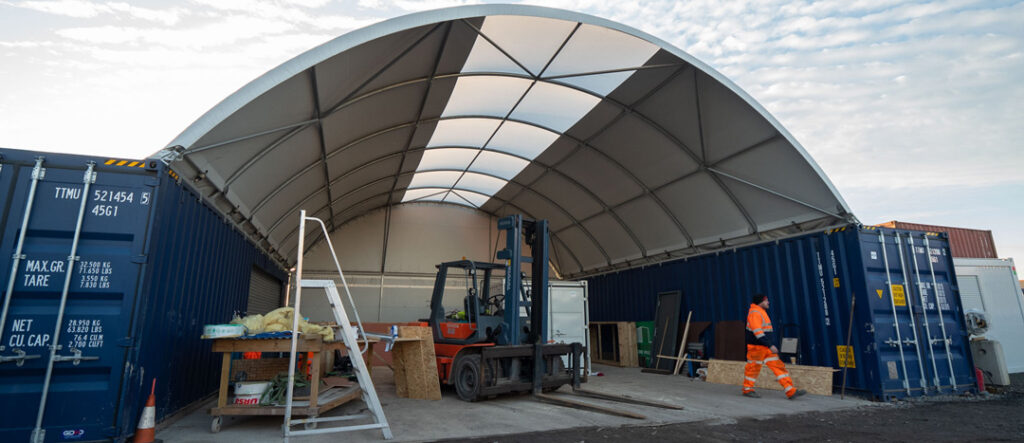Various container canopy types and more permanent structures such as steel sheds have been some of the most popular choices for storage, warehouses and workshops. Although steel sheds have generally been favoured, the advancements in material science and the cost-effectiveness of container canopies have made them a more versatile alternative—and the McGregor Group has been leading the market with Shield Canopy™—our flagship container canopy.
In this post, let’s explore the advantages of container canopies over permanent structures and how the different container canopy types can meet varying business needs.
The differences between container canopies and permanent structures
- Working environment
Traditional steel sheds and other permanent structures generally lack proper ventilation, which can lead to many issues attributed to high-moisture environments such as pests and mould. This can impact both the health of the individuals working within these structures as well as any goods stored in them.
In contrast, container canopies like Shield Canopy™, offer a more open and well-ventilated working environment. The open front and integrated light strips of this canopy provide natural illumination. This creates a comfortable and well-lit working environment, ideal for workshops or storage spaces where extended periods are spent.
- Groundworks
One of the main advantages of Shield Canopy™ and other similar container canopies is that they require little to no groundwork, as they can be attached directly to one or multiple 20ft and 40ft shipping containers. Since Shield Canopy™ is made to standard sizes, it also gives us more time to rigorously test the structures before deployment. This enables us to guarantee resistance against Beaufort 10 winds for five years.
On the other hand, erecting a permanent structure will involve a lot of pre-construction groundwork to ensure the structure has a solid foundation to support its weight and be stable, this makes permanent structures drastically more expensive than container canopies—not to mention the extended project timelines to deploy such structures.
- Permanent vs. semi-permanent structures
Container canopies are semi-permanent structures, which means they can be easily dismantled and moved when needed. However, this does not mean they are flimsy and less reliable than permanent structures. McGregor’s Shield Canopy™ comes with a guaranteed lifespan of five years.
Compared to semi-permanent container canopies, permanent structures are a lot less flexible in terms of how they can be used. Also, if these structures were erected to house equipment for a temporary need and are not required once the project is complete, they most often need to be demolished, which increases maintenance costs and is detrimental to the environment.
- Planning permission
Obtaining planning permission can be a complex process. Businesses often need to wait for their building plan to get approved before they can get started with building their permanent structures.
Container canopies, on the other hand, may not require any planning permission as they are considered semi-permanent structures. While this is dependent on local government policies, most of the time there’s no need to seek permission from authorities to deploy a container canopy.
- Maintenance
One of the biggest differences between container canopies and permanent structures made of steel and wood is maintenance. Permanent structures can be difficult to maintain depending on the materials used and the climatic conditions. Sheds are prone to wear and tear, requiring regular upkeep to prevent issues such as rotting, rusting, or cracking, which is both time-consuming and expensive.
However, the Shield Canopy™ is built using galvanised steel frameworks, which eliminates the possibility of rusting. They are also much easier to clean should there be a need for it.
- Lead times
As already mentioned, a lot of steps go into the construction of a permanent structure, which means it generally takes longer to build and deploy based on the size of the structure.
Since container canopies are made to standard sizes, it’s much easier to install and deploy. At McGregor Group, we prioritise quick delivery and installation of container canopies—and the Shield Canopy™ can be installed in as little as 48 hours.
Different container canopy types
Container canopies can be acquired in various configurations, some of the most common include:
Standard container canopies: These container canopies attach directly to 20ft and 40ft shipping containers, offering a secure and weather-protected environment for working or storing goods.
Double-bay container canopies: These are installed on three shipping containers arranged side by side, which offer a larger sheltered space. These are perfect for storing large items or to be used as a workshop.
Triple-bay container canopies: These are similar to double-sided container canopies but extend across three bays. They are more useful for industrial applications.
Choose container canopies for better flexibility, cost-effectiveness and ease of deployment
When it comes to cost-effective sheltering options for storage bays, warehouses, and workshops, container canopies are the best choice. They offer flexibility, safety, and weather protection while being easier and cheaper to deploy and maintain than traditional permanent structures.
There are also many container canopy types to choose from depending on your specific needs and requirements. If you’re considering container canopies, choose a reputed manufacturer like McGregor Group for high-quality offerings.

Andrew Greening
ATG Site Services Ltd
Our production facility needed a sheltered, weather-resistant space that could be supplied quickly. McGregor Structures’ rapid delivery and installation process resulted in a fantastic new production zone for us, and their team was a pleasure to work with.
